Lab Manual: Comparison of Diagonals in Different Quadrilaterals - Class 9 PDF Download
Objective
To explore the similarities and differences between the different quadrilaterals like parallelogram, rectangle, rhombus and square with respect to their diagonals.Prerequisite Knowledge
Properties of parallelogram, rectangle, square, rhombus.
- In parallelogram, diagonals are not equal.
- In rectangle, diagonals are equal.
- In rhombus, diagonals are not equal but bisect each other at 90°
- In square, diagonals are equal and bisect each other at 90°.
Materials Required
Glazed papers, ruler, a pair of scissors, pencil, tracing paper.
Procedure
Case I- Make a parallelogram on a glazed paper by paper folding and name it as ABCD. Join AC and BD.
- Draw and cut replicas of AABC and ABCD. Coincide the diagonals AC and BD.
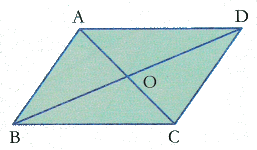
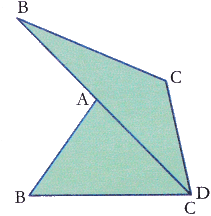 Observation
Observation
We observe that diagonal AC ≠ diagonal BD.
Case II
- Make a rectangle by paper folding on a glazed paper. Name it as PQRS. Join PR and QS.
- Cut replicas of ∆PQS and ∆PQR and name them as ∆BCA and ∆EFD.

- Place two replicas such that AC and ED coincise eachother and side AB is opposite to side FD.
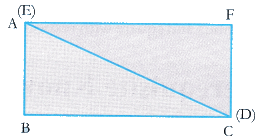 Observation
Observation
Here we notice that AC = DE. (as they overlap each other)
∴ diagonal AC = diagonal DE
∴ QS = PR
Case III
- Make a rhombus by paper folding on a glazed paper. Name it as ABCD. Join AC and BD.
- Draw and cut replicas of ∆ABC and ∆DCB and name them as ∆PQR and ∆MNO’ respectively.
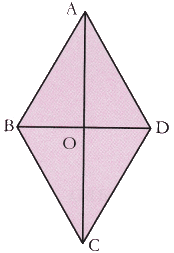
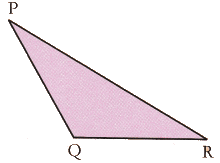
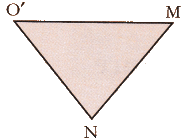
- Place two replicas such that PR and MO’ coincide each other.
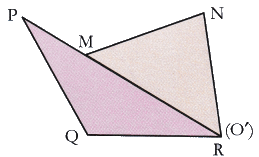 Observation
Observation
We observe thatPR ≠ O’M.
∴ diagonal AC ≠ diagonal BD - Draw and cut replicas of ∆AOB and ∆BOC and verify the congruency of two triangles by placing one over other.
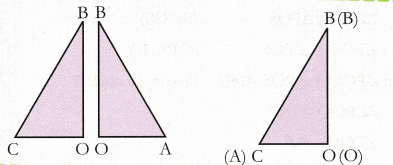 Here BC = AB
Here BC = AB
OB = BO
OC = OA
∴∆BOC = ∆BOA
∴∠BOC = ∠BOA
∴∠BOC + ∠BOA = 180° (linear pair angles)
2∠BOC = 180° [from (i)]
∴ ∠BOC = 90°
Thus, it is verified that in a rhombus, diagonals are not equal but bisect each other at 90°.
Case IV
- Make a square by paper folding on a glazed paper. Name it as PQRS. Join PR and SQ.
- Draw and cut replicas of ∆PQS and ∆PQR.
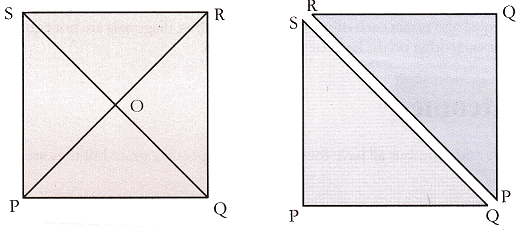
- Place two replicas along their diagonals SQ and PR. Here, we observe that both diagonals overlap each other completely. Thus, diagonal SQ = diagonal PR.
- Draw and cut replicas of ∆POQ and ∆POS. Place these replicas as shown in fig. below.
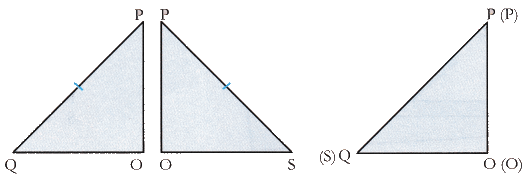
Observation
Here, PQ = SP (sides of a square)
OP = OP (common side)
OQ = OS (By observation)
∆POQ = ∆POS (By SSS)
∴ ∠POQ = ∠POS (C.P.C.T.)
But ∠POQ + ∠POS = 180° (linear pair angles)
2∠POQ = 180°
∠POQ = 90°
This implies that in a square, diagonals are equal and bisect each other at 90°.
Observation
By paper folding and cutting activity it is very much clear that rectangle, square, rhombus and parallelogram differ by their diagonal properties.
In parallelogram, diagonals are not equal, in rectangle diagonals are equal, in rhombus diagonals are not equal but bisect each other at 90°, in square, diagonals are equal and bisect each other at 90°.
Result
We verified that, in parallelogram diagonals are not equal, in square diagonals are equal and bisect each other at 90°. In rectangle diagonals are equal and bisect each other at 90°. In rhombus, diagonals are not equal but bisect at 90°. In this way these figures differentiate each other on the basis of their diagonals.
Learning Outcome
Though square, rectangle and rhombus all have the properties of parallelogram but they are different on the basis of their diagonals.
Activity Time
Draw all types of quadrilaterals on the same plane by using different glazed paper.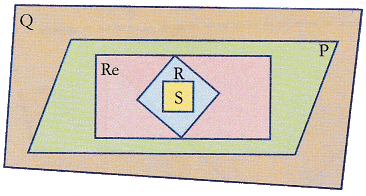 Q – Quadrilateral
Q – Quadrilateral
P – Parallelogram
Re – Rectangle
R – Rhombus
S – Square
We conclude that, all squares are rhombus, rectangle and parallelogram.















